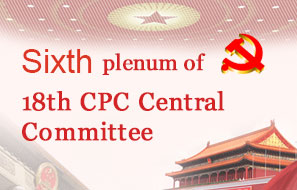China issues white paper on right to development
II.The System Ensuring the People's Right to Development
China has established an integrated system of legislature, strategy development, planning, and judicial remedy to ensure its people's right to development, and makes continued efforts to improve it. The people's right to development is realized through a framework of institutions, strategies, policies and measures that are constructive, practical, efficient, and compulsory.
The Constitution and Laws
China has established a legal system with Chinese characteristics. With the Constitution at the core, it is based on laws related to the Constitution, the civil laws, the commercial laws, and other major branches of the laws, and consists of laws, administrative regulations, and local regulations, providing a legal basis for the people's right to development.
As the nation's fundamental law, the Constitution establishes and protects the people's right to development in all respects. In the Preamble, equal development is set as the fundamental guiding principle, and the nation's core task is to "promote the coordinated development of the material, political and spiritual civilizations, and to turn China into a socialist country that is prosperous, powerful, democratic and culturally advanced." The Constitution establishes such principles as the people's democracy, equal development, and stipulates that "All power in the People's Republic of China belongs to the people"; "The people administer state affairs and manage economic and cultural undertakings and social affairs through various channels and in various ways in accordance with the provisions of law"; "The state develops a relationship of equality, unity and mutual assistance among all of China's nationalities." Article 33 of the Constitution sets the fundamental principle that "The state respects and preserves human rights." In Chapter II, the Constitution stipulates the Chinese citizens' right to economic, political, cultural, and social development.
China has promulgated and implemented a series of laws and regulations to protect the right to development of all citizens, especially that of the ethnic minorities, women, children, senior citizens, and the disabled. The Law on Regional Ethnic Autonomy stipulates that people of all ethnic minority groups shall "speed up the economic and cultural development of the ethnic autonomous areas, work towards their unity and prosperity, and strive for the common prosperity of all ethnic groups and for the transformation of China into a socialist country with a high level of culture and democracy." The Law on the Protection of Women's Rights and Interests stipulates that "Women shall enjoy equal rights with men in all aspects of political, economic, cultural, social and family life. It is a basic state policy to realize equality between men and women. The state shall take necessary measures to gradually improve various systems for the protection of the rights and interests of women and to eliminate all kinds of discrimination against women." The Law on the Protection of Minors stipulates that "Minors shall enjoy the right to life, the right to development, the right to being protected, and the right to participation." The Law on the Protection of the Rights and Interests of the Elderly stipulates that "The state shall protect the lawful rights and interests of the elderly. The elderly shall have the right to obtain material assistance from the state and society, the right to enjoy social services and social preferential treatment, and the right to participate in social development and share the achievements in development." The Law on the Protection of Disabled Persons stipulates that "Disabled persons shall enjoy equal rights with other citizens in political, economic, cultural, social, family life and other aspects."
National Development Strategies
The world is a colorful place, with many different development patterns. Summarizing its historical experience and based on its prevailing conditions, China has chosen a socialist path. It strives to build socialism with Chinese characteristics, create a beautiful life for the Chinese people, and realize the people's right to development.
To build socialism with Chinese characteristics, China sets its national development strategies based on the need to protect and realize its people's right to development. In the early 1980s, the CPC proposed the "three-step" development strategy: First, to double the 1981 GNP and ensure the provision of basic material needs by 1990; second, to double the 1991 GNP by the end of the 20th century and bring people's living standards to a level of "reasonable prosperity"; and third, to quadruple that new GNP to the level of moderately developed countries by the mid-21st century, and bring the Chinese people an affluent life.
At the 15th CPC National Congress in 1997, the third step was made more specific, and a new "three-step" strategy for the first half of the 21st century was put forward. First, in the first decade of the 21st century, to double GNP compared to the 2000 level, raise levels of prosperity, and form a relatively complete socialist market economy; second, with ten more years' hard work, to further develop the economy and improve various institutions by the centenary of the founding of the CPC; and third, to achieve basic modernization and complete the building of a socialist country that is prosperous, democratic, and culturally advanced by the centenary of the founding of the People's Republic of China in the mid-21st century.
After entering the 21st century, the CPC set itself the strategic task of building a "moderately prosperous society in all respects." Since the 18th CPC National Congress in 2012, the Party's Central Committee, with Xi Jinping as its core, has set the "people's wish for a better life" as its goal of governance, and defined the Two Centenary Goals. That is, to enable the people to live prosperous lives and complete the building of a moderately prosperous society in all respects by 2020, the centenary of the CPC (founded in 1921), and to bring China's per capita GDP on par with that of moderately developed countries, and build China into a modern socialist country that is prosperous, strong, democratic, culturally advanced, and harmonious by the centenary of the PRC (founded in 1949) in the mid-21st century.
To achieve the Two Centenary Goals, the CPC strives to promote coordinated progress in economic, political, cultural, social, and ecological areas, and to implement the Four-pronged Comprehensive Strategy, viz., building a moderately prosperous society in all respects, driving reform to a deeper-level, fully implementing the rule of law, and strengthening Party discipline. Based on economic growth, the Party will continue to build the socialist market economy, promote democracy, advanced culture, ecological progress, and a harmonious society, and ensure that the people are better-off, that the nation grows stronger and more prosperous, and that the environment is clean and beautiful, and that the people's right to development is protected and promoted in a more solid and effective manner.
Overall Development Plans
In accordance with the goal to build a modern socialist country and the associated development strategies, the Chinese government regularly makes national development plans to ensure the people's right to development. In the period between 1953 and 2001, it issued national development plans every five years addressing issues concerning the country's economy, culture, and society. After 2006 the plan has been changed to program which is less detailed, with fewer numerical targets to guide the macro-economy and social development. To date China has made 13 consecutive five-year plans (including the program starting from 2016) for the nation's economic and social development. These plans have connected the country's overall development goals to the concrete plans to implement them, and are divided into different stages to steadily promote the people's right to development, with mid-and long-term guidelines, goals and directions, basic requirements, and specific measures.
On October 29, 2015, the Fifth Plenary Session of the 18th CPC Central Committee approved the "Suggestions of the CPC Central Committee on Developing the 13th Five-Year Program for National Economic and Social Development." On March 16, 2016, the Fourth Session of the 12th National People's Congress approved by vote the "Outline of the 13th Five-Year Development Program of the People's Republic of China for National Economic and Social Development." Following the new philosophies on development and based on universal participation and benefits, China stresses equal opportunities, with an emphasis on ensuring basic living standards, improving the people's wellbeing, and realizing a moderately prosperous society for all the people. China has made breakthroughs in equal access to the fruits of development, mainly in increasing the supply of public services, carrying out poverty eradication programs, enhancing the quality of education, granting equal access to educational resources, promoting employment and entrepreneurship, bridging the income gap, establishing a fairer and more sustainable social security system, enhancing public health and fitness, and strengthening the balanced development of the people.
China ensures its people's right to development also by making national human rights action plans. It has issued the "National Human Rights Action Plan" (2009-2010), (2012-2015), and (2016-2020). In these plans, the government puts the people's right to development at the core of human rights, and strives to address the most immediate problems that are of the most concern to the public. While promoting the sound and rapid development of the economy and society, China ensures that all members of the society enjoy the rights to equal participation and equal development.
Special Action Plans
The Chinese government formulates special action plans in the fields of economy, culture, society, and environment to ensure people's right to development. It has implemented a wide array of action plans in areas such as poverty alleviation, the Internet, innovation and entrepreneurship, science and technology, trade, and regional development. Specifically, these plans have been designed to promote entrepreneurship and innovation among farmers, to send agricultural specialists to rural areas to develop agriculture, to develop rural and agricultural resources in support of rural migrant workers who return to their home villages to start businesses, to improve people's lives by developing high-tech industries in selected counties, to transform the growth model of the western areas through science and technology, and to revitalize the old industrial bases in the Northeast through science and technology. The state has effectively implemented a series of action plans regarding educational development, health improvement, awards for high-caliber professionals, and the cultural industry, such as the action plans to revitalize education in the 21st century, to enhance teachers' status in the stage of compulsory education in rural areas, to promote special education, to help girls who have dropped out of school to return to campus, and to support the more developed cities in the eastern areas to train professionals for the western areas. China has implemented a series of action plans regarding employment, social security, food and medical care, disability prevention, and health and fitness, such as the Spring Breeze Action Plan to promote employment, and other plans to realize full coverage of social security, to eliminate malaria, to prevent and control nosocomial infection, to carry out rehabilitation programs for children with impairments and disabilities, to reduce the number of newborns with defects and disabilities, to prevent incidences of disability, and to improve the nutritional status and fitness of the Chinese.
The state has issued action plans on pollution prevention and control, energy conservation, and biodiversity, such as action plans to prevent and control water pollution, to reduce high-risk pollutants, to utilize coal in a clean and efficient manner, to upgrade and renovate coal power for energy saving and emissions reduction, to build obstacle-free cities or counties for the disabled, and to protect biodiversity.
China has also made special plans to ensure the right to development of ethnic minorities, women, children, the elderly, and the disabled. The plans include those on the development of ethnic minorities, of women, of children, of the elderly, and of the disabled persons, with clear goals and targeted policies for different groups to solve the problems hindering their development, ensuring that they can pursue self-development and enjoy the fruits of reform on an equal basis.
The Judicial Remedy Mechanism
China is making enhanced efforts to strengthen the judicial protection and remedy to ensure the people's right to development. It has built a judicial remedy mechanism in this regard to prevent and punish infringements of people's right to development.
The government is driving the reform of the judicial relief system to a deeper level to ensure the right to development of disadvantaged groups. The state provides judicial relief to victims of crimes or parties suffering from infringements of civil rights who cannot obtain effective compensation through litigation, and provides help to parties in certain types of cases who are in dire need of relief and are entitled to such relief. Eligible parties mainly receive relief money, and help in the forms of consultation and education. Judicial relief complements legal aid and litigation relief, and is linked with other forms of social relief and aid. The government is conducting research on opening first-aid fast track at hospitals for those injured in criminal cases, providing psychotherapy for victims with severe PTSD cases, and sending social workers to help immobilized victims, so as to further enhance judicial relief. In 2014 the state issued the "Opinions on Establishing and Improving the National Judicial Relief System (trial)," which was followed by a marked expansion in the scale and increases in the number of judicial relief cases. In 2014 and 2015, the central government and local governments allocated a total of RMB2.47 billion and RMB2.95 billion for judicial relief funds, benefiting over 80,000 parties concerned in 2014. In 2013-2015 people's courts at all levels reduced or exempted a total of RMB625 million for litigation parties, ensuring the right to litigation of the poor.
The government strives to strengthen the effectiveness of legal aid, and ensures the right of impoverished people to judicial relief. In 1994, China began to form a legal aid system, providing free consultation, agency, criminal defense, and other legal services to people in need. In 2003, the State Council issued the Regulations on Legal Aid to define the scale of legal aid, delegating the power to the people's governments of provinces, autonomous regions, and municipalities directly under the central government to supplement the issues to be covered by legal aid, and set the standards for receiving legal aid in light of the local conditions. Currently there are 23 provinces that have expanded the scope of issues covered by legal aid, and 19 provinces have adjusted the standards for receiving legal aid. The Criminal Procedural Law (revised in 2012) included suspects as recipients of legal aid, alongside defendants. Over the past five years, the number of legal aid cases has been growing by 11.4 percent annually, and women, children, the elderly, the disabled, and rural migrant workers have received timely and higher quality legal aid services. In May 2015, at its 12th meeting, the CPC Central Leading Group for Overall and Further Reforms reviewed and approved the "Opinions on Improving the Legal Aid System," with measures to further enlarge the coverage of legal aid for civil and administrative lawsuits, reduce the thresholds for receiving legal aid, and gradually make legal aid available to low-income groups to benefit people in need. The government strengthens judicial remedy to protect the right to development of disadvantaged groups. China has always attached importance to the judicial protection of the right to development and other basic human rights in criminal cases. The state punishes crimes targeted at women, children, the elderly, the disabled, and rural migrant workers, and strengthens the protection of special groups' rights to healthy physical and psychological development and their economic and social rights. The government strives to prevent or severely punish the abduction and trafficking of women and children, and such crimes have been effectively curbed. The state has issued the "Opinions on Punishing Sex Crimes Against Minors" and the "Opinions on Handling the Infringements of Minors' Rights and Interests by Guardians," so as to enhance the judicial protection of minors' rights and interests. The state has promulgated the "Opinions on Safeguarding the Legitimate Rights and Interests of Disabled Persons in Procuratorial Work," mandating severe punishment for crimes that infringe upon the rights and interests of disabled people in accordance with the law.
The government attaches importance to the role of arbitration, and protects the equal right to development of certain groups. By ending disputes through arbitration and punishing infringements according to law, China endeavors to strengthen procedure-based protection of the people's rights. By the end of 2015, 80 percent of township-and community-level employment and social security centers had set up organizations to mediate labor disputes, up by 14 percent from the 2014 figure. A total of 2,919 administrative divisions at or above county level (about 91 percent of the total) had arbitration offices for labor disputes, up by 208 percent compared with the figure of 946 at the end of the 11th Five-Year Plan period (2006-2010). In 2010-2015, China's mediation and arbitration organizations handled a total of 7.57 million cases, bringing 90 percent to a conclusion.

























